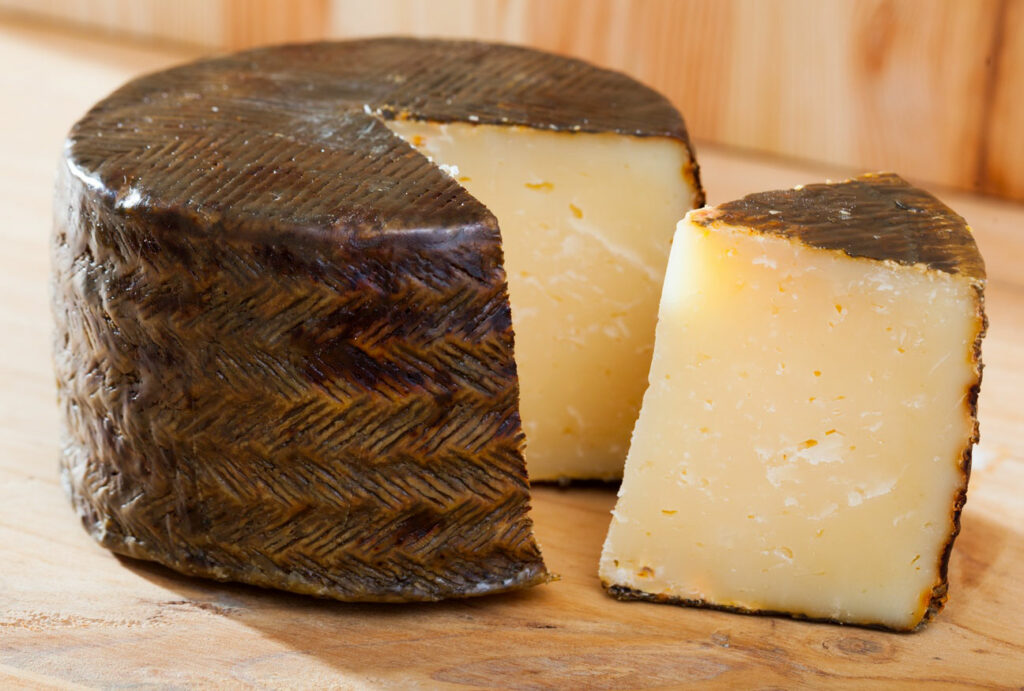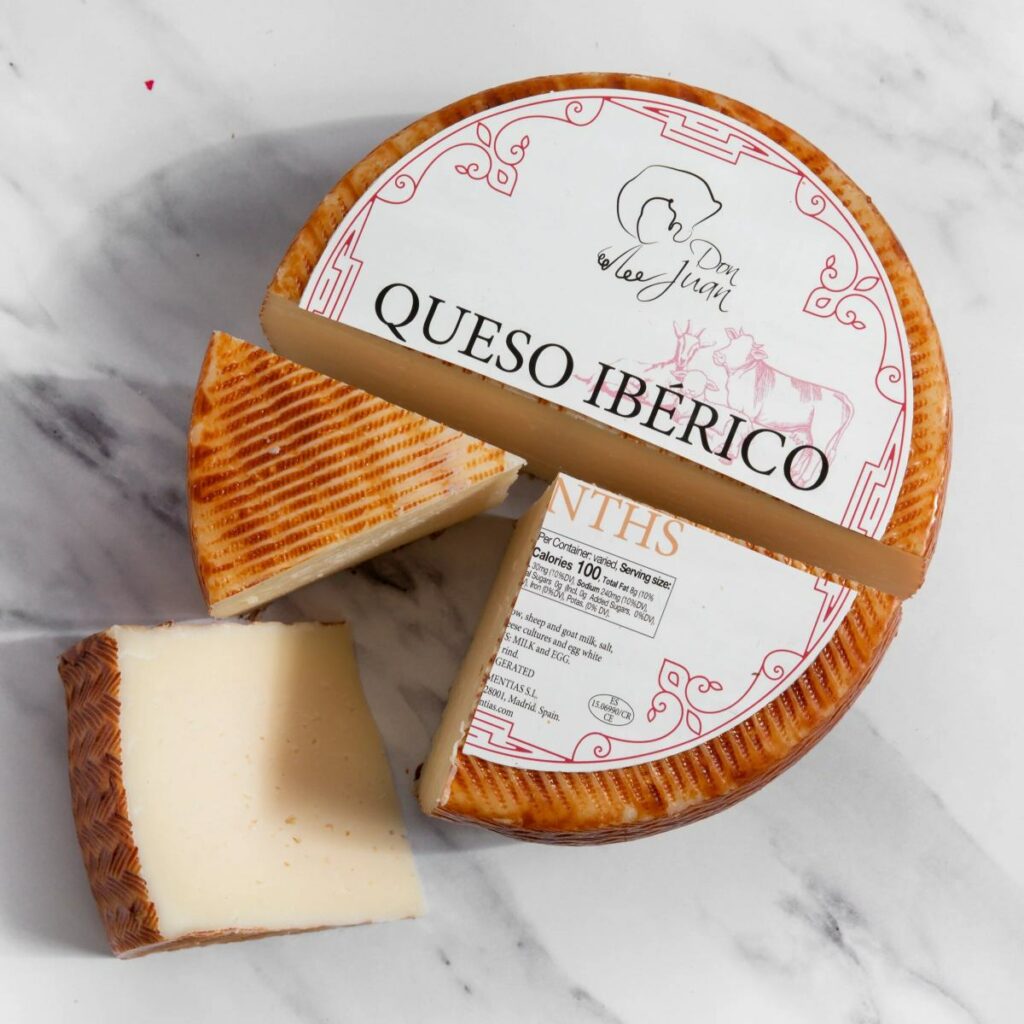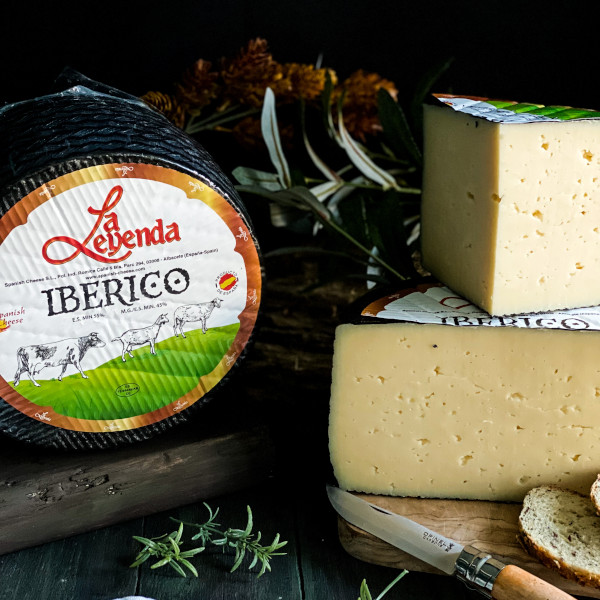What is Queso Iberico? A Journey through Taste and Tradition

In this exploration, we step off the beaten path and dive into the rich, savory world of Queso Iberico, Spain’s lesser-known culinary jewel.
This isn’t just another cheese guide; it’s a voyage through the rolling pastures of the Iberian Peninsula, a peek into centuries-old cheese-making traditions, and a celebration of the complex flavor profiles that make Queso Iberico a gastronomic treasure.
Whether you’re a dedicated cheese connoisseur or a curious food enthusiast, prepare to discover the unique allure of Queso Iberico, an experience that transcends the ordinary and borders on the extraordinary.
Quick Facts About Queso Iberico
| Quick Facts | Description |
|---|---|
| Origin | Spain |
| Milk Source | A mix of cow’s, sheep’s, and goat’s milk |
| Texture | Semi-hard, compact |
| Flavor | Mild, slightly piquant |
| Color | Ivory |
| Aging Process | 1-2 months |
| Uses | Ideal for tapas, grating over pasta, or melting in recipes |
| Production Process | The curd is cut, pressed, and then aged |
What is Iberico cheese?
Iberico cheese, also known as Queso Iberico, is a popular Spanish cheese made from a blend of cow’s, sheep’s, and goat’s milk. The proportions of the milk used can vary, but typically, it contains about 50% cow’s milk, 30% sheep’s milk, and 20% goat’s milk.
The cheese is firm and slightly oily, with a yellow to light brown rind. It has a buttery and nutty flavor with a slight piquancy, and the taste becomes more intense as the proportion of sheep’s milk increases. Iberico cheese is often used in cooking, especially in traditional Spanish dishes, but it can also be enjoyed on its own or with crackers and fruit.
Also read: 11 Best Crackers that Pair Well with Cheese
Note: the term ‘Iberico’ is also used to describe the famous Iberico ham (Jamon Iberico) produced in Spain, which is made from the native black Iberian pig.
What is Queso Iberico used for? 6 ways to eat Iberico cheese
Queso Iberico is a versatile cheese that can be used in a variety of ways in both cooking and as a standalone snack.
- Tapas: In Spain, it’s common to see Queso Iberico served as tapas. It can be served on its own or paired with olives, cured meats, and crusty bread.
- Cheese Board: Due to its unique flavor profile, Queso Iberico makes an excellent addition to any cheese board. It pairs well with fruits like apples and pears, as well as with a variety of wines.
- Cooking: Queso Iberico can be used in a variety of dishes. It melts well, making it a good choice for sandwiches, pizzas, casseroles, and pasta dishes.
- Salads: Cubes or slices of Queso Iberico can be added to salads to add a burst of flavor and a creamy texture.
- Desserts: In some regions, it’s also used in sweet dishes and can be served with honey or quince paste for a delightful dessert.
- Paired with Wine: Iberico cheese pairs well with a variety of wines. Try it with a crisp white wine like Albariño, or a light, fruity red like Tempranillo.
The flavor of Queso Iberico intensifies when served at room temperature, so it’s best to take it out of the fridge about an hour before serving or using it in dishes.
Is Iberico cheese the same as Manchego?
No, Iberico cheese and Manchego cheese are not the same, although both originate from Spain and are often compared due to their similar texture and flavor profiles.
Manchego:

Manchego cheese is made only from the milk of the Manchega sheep found in the La Mancha region of Spain. It has a distinctive herringbone rind and is aged for varying lengths of time, resulting in different flavors and textures. Young Manchego cheeses (fresco) are mild and creamy, while the aged ones (curado and viejo) are more robust and tangy.
>> Click here to read our in-depth guide on Manchego
Iberico cheese:

On the other hand, Iberico cheese, as mentioned earlier, is made from a blend of cow’s, sheep’s, and goat’s milk. The proportions can vary, but it usually contains about 50% cow’s milk, 30% sheep’s milk, and 20% goat’s milk. The flavor of Iberico cheese is also buttery and nutty, with a slight piquancy.
So, while they might share some characteristics, they are distinct cheeses with unique flavors and compositions.
The Differences Between Queso Iberico and Manchego
| Aspect | Queso Iberico | Manchego |
|---|---|---|
| Origin | Spain | La Mancha region, Spain |
| Milk Used | Blend of cow’s, sheep’s, and goat’s milk | Manchega sheep’s milk |
| Flavor Profile | Buttery and nutty with a slight piquancy | Younger (fresco): Mild and creamy. Older (curado, viejo): Robust and tangy |
| Texture | Firm and slightly oily | Firm, compact |
| Rind | Yellow to light brown | Distinctive herringbone pattern |
| Aging Period | Varies, but typically less than Manchego | Fresco: 2 weeks. Semi-curado: 3-4 months. Curado: 1 year. Viejo: 2 years |
| Use in Cooking | Versatile, used in a range of dishes | Used in many traditional Spanish dishes, also served as tapas |
What does Iberico cheese taste like?

Queso Iberico, made from a blend of cow’s, sheep’s, and goat’s milk, offers a unique flavor profile that is often described as balanced and smooth. It has a mild to medium intensity with a slightly nutty and buttery taste. There’s also a hint of tanginess, likely due to the goat’s milk.
The texture of the cheese is firm but tends to be quite creamy, especially when it reaches room temperature or is melted. The aftertaste is pleasant and lingers, allowing you to savor the flavors.
The overall taste can vary slightly depending on the specific ratio of the three types of milk used in the cheese’s production. Regardless, its distinctive taste makes Queso Iberico a favorite among cheese lovers and a delightful addition to any cheese board or recipe.
Iberico cheese tasting notes
- Appearance: Iberico cheese has a firm texture with a yellow to light brown rind. The interior paste is typically a pale ivory or yellow color, depending on the blend of milk and the aging process.
- Texture: The texture of Iberico cheese is firm yet slightly oily, similar to many hard cheeses. It has a smoothness that allows it to melt beautifully in your mouth.
- Aroma: The aroma of this cheese can vary based on the proportions of the different milks used, but generally, it has a mild, creamy scent with a subtle hint of the barnyard from the sheep’s milk.
- Flavor: Iberico cheese has a complex flavor profile due to the blend of three types of milk. It starts with a buttery and creamy taste, thanks to the cow’s milk. Then, you’ll notice a slightly tangy and sharp flavor derived from the goat’s milk. Finally, there’s a nutty, sweet richness that comes from the sheep’s milk. This combination makes it more complex than cheese made from a single type of milk.
- Aftertaste: The finish is typically long and pleasant, with a slight piquancy that lingers on the palate. This is especially true if the cheese has been aged for a longer period of time.
- Pairings: Iberico cheese pairs well with a variety of foods and drinks. It’s excellent with fruits like apples and pears, and it goes well with both red and white wines, depending on its age. Younger Iberico cheeses are often paired with light, fruity reds or crisp whites, while older, more robust Iberico cheeses can stand up to fuller-bodied reds.
Is Queso Iberico healthy?
Queso Iberico, like many cheeses, can be part of a healthy diet when consumed in moderation. It’s important to consider its nutritional content and how it fits into your overall dietary needs and goals.
- Nutritional Content: Queso Iberico is high in calories and fat, with 36.4 grams of fat per serving. It also contains a significant amount of sodium (2300 mg) – source
- Health Benefits: Cheese, in general, is a good source of protein, healthy fats, bone-building calcium, vitamins A and B12, and minerals. These nutrients are essential for various bodily functions, including muscle development, bone health, and the functioning of the nervous system.
- Considerations: Despite its nutritional benefits, Queso Iberico’s high calorie, fat, and sodium content means it should be eaten sparingly, particularly for individuals monitoring their intake of these nutrients.
As with any food, the key to including Queso Iberico in a healthy diet is balance and moderation. Pairing it with other healthy foods like fruits, lean proteins, and whole grains can help ensure you’re getting a well-rounded diet.
Remember, individual dietary needs can vary greatly, so it’s always a good idea to consult with a healthcare provider or nutritionist for personalized advice.
Best Queso Iberico substitutes
| Substitute | Description |
|---|---|
| Manchego | This Spanish cheese has a similar texture and rich flavor to Iberico. It’s made from sheep’s milk and aged for several months. |
| Provolone | An Italian cheese, Provolone offers a similar semi-hard texture and slightly sweet flavor. It also melts well. |
| Gouda | A Dutch cheese, Gouda’s buttery and nutty flavor can substitute for Iberico in many recipes. It also melts nicely. |
| Emmental | This Swiss cheese is slightly sweet and nutty, which can mimic the flavor profile of Iberico. It’s great for melting. |
| Jarlsberg | This Norwegian cheese is nutty and mild, similar to Iberico. It’s also a good melting cheese. |
| Mahón | Another Spanish cheese, Mahón has a slightly salty taste and creamy texture that can serve as a good stand-in for Iberico. |
| Monterey Jack | This American cheese is mild in flavor and melts easily, making it a versatile substitute for Iberico. |
| Edam | This Dutch cheese is semi-hard like Iberico and has a mild, slightly nutty flavor. |
| Havarti | A Danish cheese, Havarti is creamy with a slightly tangy taste. It can be used as an alternative to Iberico in many dishes. |
| Muenster | This American cheese is smooth and mild, with a good melting quality. It can substitute for Iberico in recipes that require melted cheese. |
What goes well with Queso Iberico?
Food that goes well with Iberico cheese
| Category | Foods |
|---|---|
| Bread/Crackers | Baguette, whole grain crackers, sourdough bread |
| Fruits | Apples, pears, grapes, figs |
| Nuts | Almonds, walnuts, hazelnuts |
| Meats | Chorizo, serrano ham, prosciutto |
| Condiments | Honey, quince paste, olive oil |
| Other Cheeses | Manchego, blue cheese, soft goat cheese |
Also read: What Fruit Goes on a Charcuterie Board?
Beverage that goes well with Iberico cheese
| Category | Beverage |
|---|---|
| Red Wines | Rioja, Garnacha, Malbec |
| White Wines | Chenin Blanc, Pinot Grigio, Dry Riesling |
| Sparkling Wines | Cava |
| Fortified Wines | Sherry |
Also read: Best Wine and Cheese Pairings: The Ultimate Guide
The history and origin of Queso Iberico

Queso Iberico is a popular cheese from Spain, made from a blend of cow’s, sheep’s, and goat’s milk. The ratio of the blend used in making this hard cheese is constantly adapted to achieve the desired flavor and texture.
The origin of Iberian cheese can be traced back to the Iberian Peninsula, specifically to the regions of Spain and Portugal. Although it is believed that the Romans refined cheese-making techniques and brought them to colonized regions such as Spain as early as 200 BC, the precise origins of Queso Iberico are not well-documented. What is known is that cheese has been a staple in the Spanish diet for centuries, evolving over time with changes in livestock and farming practices.
One of the unique aspects of Queso Iberico is its combination of milk from different animals. This blend gives the cheese a distinctive taste and texture, which has helped it become one of the most popular cheeses in Spain. It is a pressed paste cheese, indicating that the curd is pressed to remove whey before the cheese is aged.
In terms of production, Queso Iberico is produced by various companies, such as La Española Meats, founded in 1982 by Juana Gimeno Faraone. The company started as a small family business dedicated to importing Spanish foods and has since grown into a major supplier of products like Queso Iberico.
In summary, Queso Iberico is a testament to Spain’s rich culinary history and its mastery of cheese-making. Its unique blend of milk and its careful production process gives it a distinctive flavor that has made it a favorite among cheese lovers worldwide.
Frequently Asked Questions
1. Where is Queso Iberico cheese from?
Queso Iberico is a Spanish cheese that originates from the country’s central region.
It’s important to note that unlike some other Spanish cheeses, such as Manchego which must be produced in the La Mancha region to carry the name, Queso Iberico does not have a Protected Designation of Origin (PDO). This means it can be made anywhere in Spain and still be called Queso Iberico.
In terms of specific producers of Queso Iberico, companies like La Española Meats and Quesos Navalmoral are known for their versions of this popular cheese. However, multiple dairies and producers across Spain contributed to the production of Queso Iberico.
2. Does Queso Iberico melt?
Yes, Queso Iberico does melt. This cheese is known for its smooth and creamy texture when melted, which makes it an excellent choice for cooking. It can be used in a variety of dishes such as grilled cheese sandwiches, macaroni and cheese, or any recipe that calls for a melting cheese.
3. Does Iberico cheese have a strong taste?
Queso Iberico has a mild to medium flavor, rather than a strong one. It’s known for its balanced and smooth taste, which is derived from the blend of cow’s, sheep’s, and goat’s milk used in its production.
The flavor profile can be described as slightly nutty and buttery with a hint of tanginess. The texture is firm yet creamy, and it has a pleasant, lingering aftertaste.
While not overly powerful, its unique flavor is distinct enough to stand out in dishes or when paired with wine and fruits on a cheese board.
4. How to properly store Iberico cheese?
Proper storage of Iberico cheese is important to maintain its flavor and prevent spoilage.
- Refrigeration: Like many other kinds of cheese, Iberico cheese should be kept in the fridge to preserve its freshness. The optimal temperature for storage is between 5-10 degrees Celsius.
- Humidity: The cheese should be stored with a humidity level of 85-90% to prevent it from drying out.
- Wrapping: It’s recommended to store cheese in a type of butcher paper rather than plastic wrap, as plastic can affect the breathability and moisture levels of the cheese. However, if butcher paper is not available, a clean, airtight container can also work.
- Freezing: While freezing is an option for longer storage, it might change the texture of the cheese. Therefore, it is not the first recommendation for preserving the quality of Iberico cheese.
- Cheese Storage Bags: Specialized cheese storage bags can also be used to keep your cheese fresher for a longer time. They are designed to maintain the right level of moisture around the cheese.
Remember, once the cheese is cut, it should be consumed within 2-3 weeks for the best taste and quality.
Also read:
- The Ultimate Guide to Basket Cheese: An Easter Delight
- All About Swiss Cheese: A Comprehensive Guide
- The Tale of Taleggio: Unveiling Italy’s Pungent Treasure
- Cotswold Cheese: A Taste of England’s Finest
- The Ultimate Guide to Hoop Cheese: A Southern Delight
- The Ultimate Guide to Chèvre: Exploring Goat Cheese
- Boursin Cheese: Unraveling the Magic of Creamy Goodness





